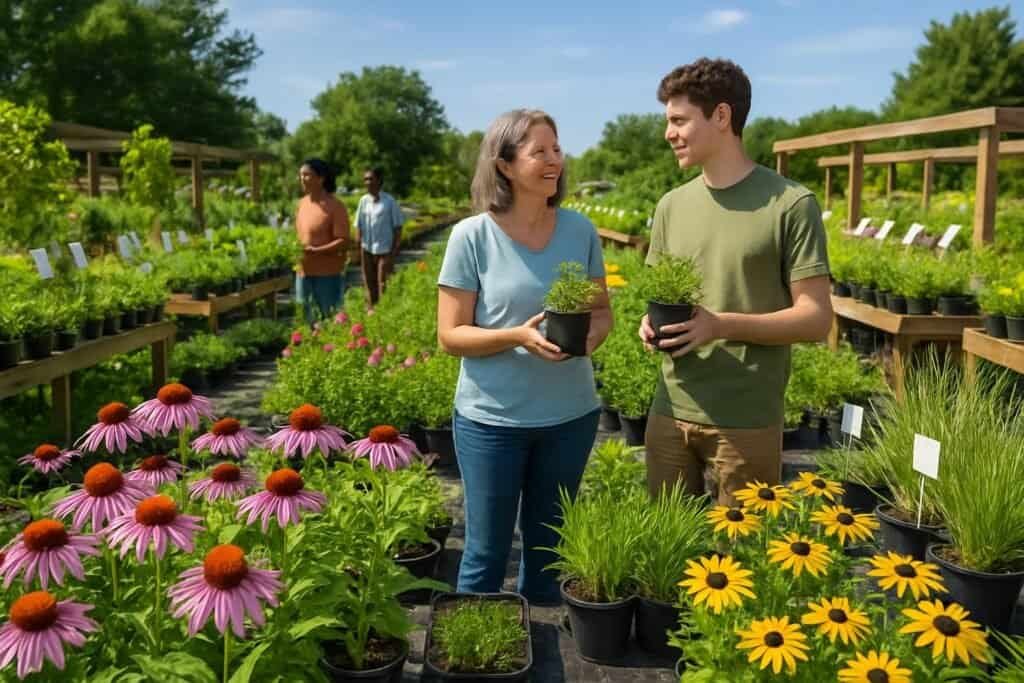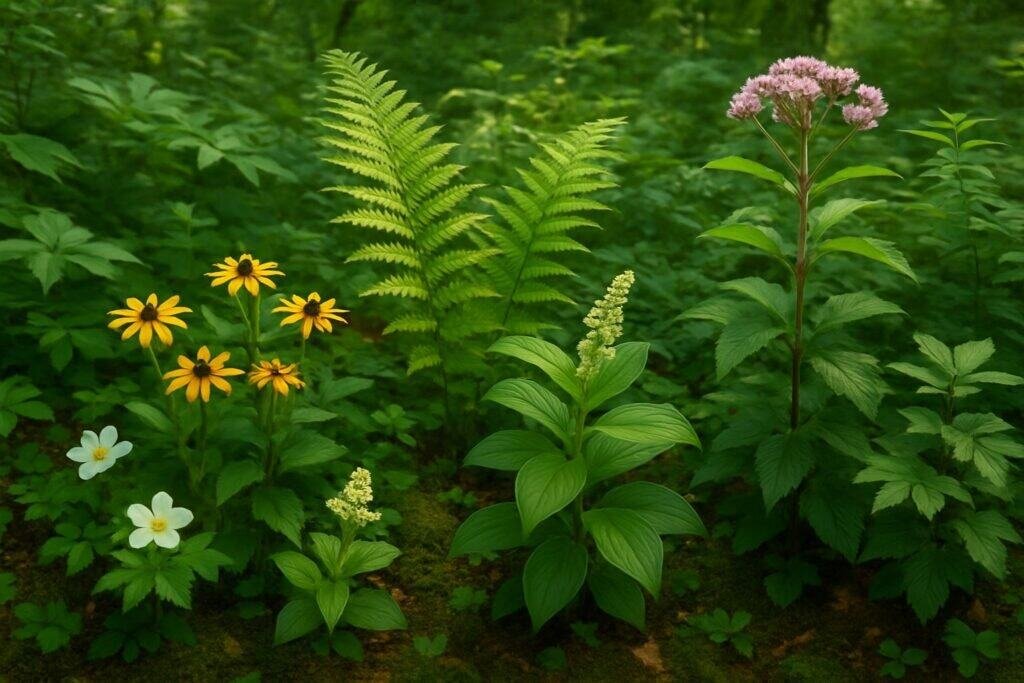Finding the perfect Indiana native plants for your garden can be a rewarding journey. These plants adapt to local conditions and support local wildlife while requiring less maintenance than non-native species.
You can purchase Indiana native plants at local nurseries specializing in native species, conservation district plant sales, botanical gardens, online native plant retailers, and seasonal farmers markets across the state.
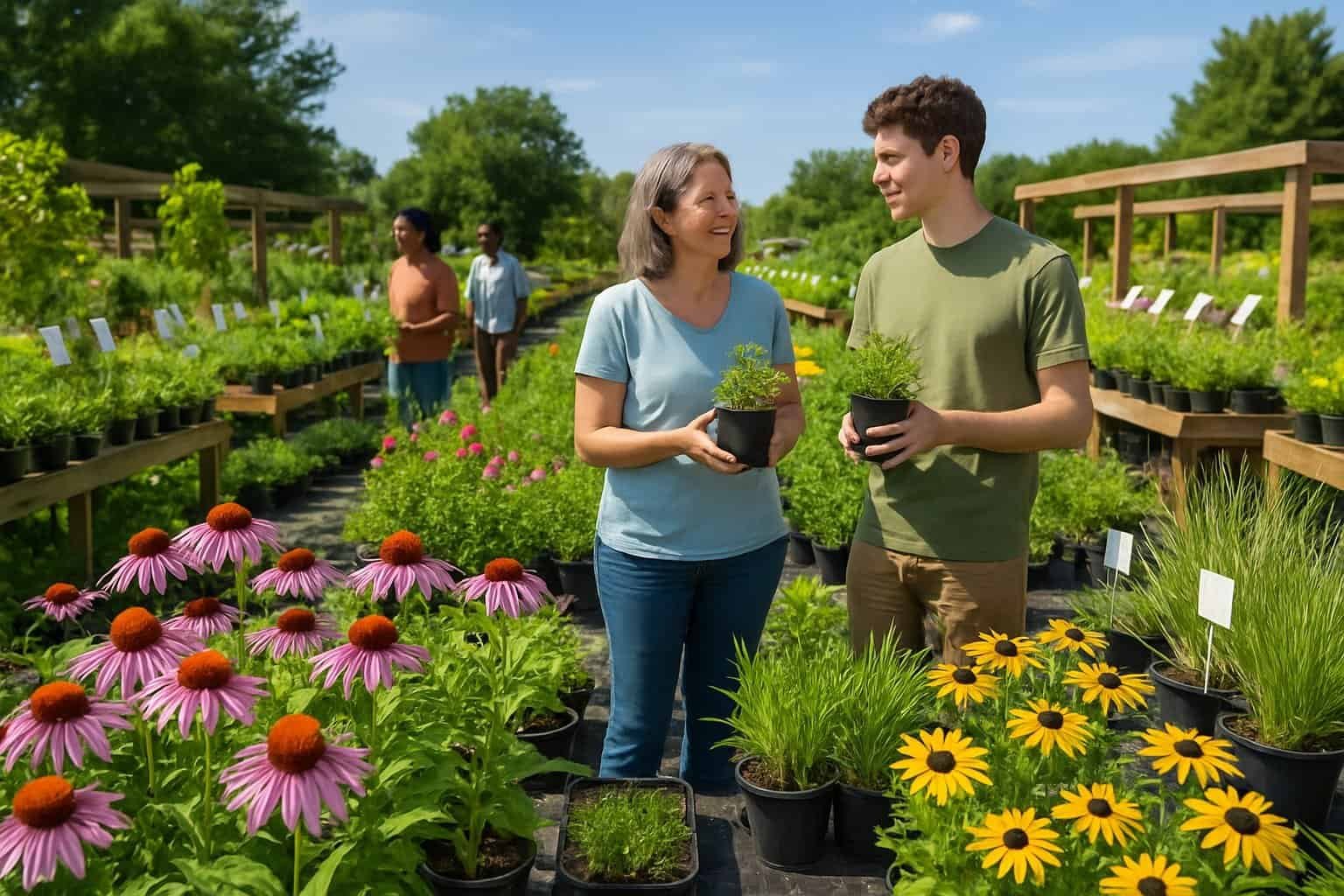
Many gardeners don’t realize how accessible native plants have become in recent years. The growing interest in sustainable landscaping has led to an expansion of businesses and organizations offering these environmentally friendly options.
From small specialty shops to large garden centers, options exist for every budget and garden size.
Key Takeaways
- Native plant nurseries and conservation district sales offer the best selection of locally-adapted plants that support Indiana’s ecosystem.
- Quality native plants require less water, fertilizer, and maintenance while providing superior habitat for local wildlife.
- Planning your native garden based on your specific site conditions will ensure the best success and ecological benefits.
Understanding Indiana Native Plants
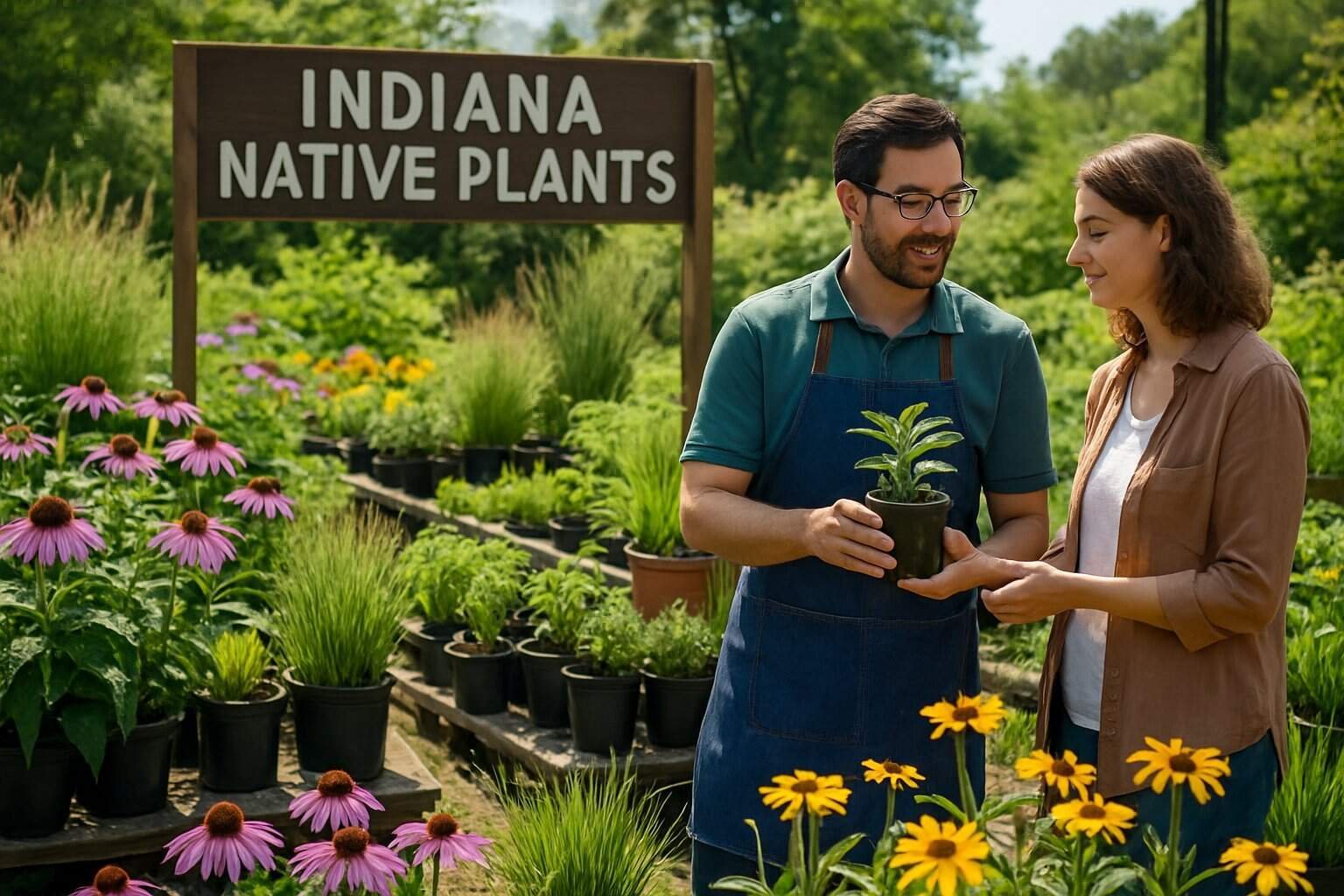
Indiana native plants have evolved in the state’s unique conditions over thousands of years. They are perfectly suited to local soils and weather patterns.
These plants provide essential habitat for local wildlife. They require less maintenance than non-native alternatives.
Benefits of Native Species
Native plants need significantly less water, fertilizer, and maintenance than non-native species. Once established, their deep root systems help prevent erosion and filter water pollutants.
These plants have co-evolved with local wildlife, providing essential food and shelter for native birds, butterflies, and beneficial insects. For example, milkweeds serve as the only host plant for monarch butterfly caterpillars.
Native species contribute to Indiana’s biodiversity and natural heritage. By choosing native plants, you help preserve the unique character of Indiana’s landscapes.
Many native options offer striking visual appeal. The white blooms of Dogwood trees in spring and the vibrant red berries of Washington Hawthorn in fall create seasonal interest in any garden.
Common Indiana Natives
Indiana offers a diverse selection of native plant species suitable for any landscape need. For shade trees, consider the majestic Oak, the stately Tulip tree, or the flowering Dogwood with its distinctive spring blossoms.
Native shrubs like Elderberry provide beautiful flowers and edible berries. Washington Hawthorn offers white spring flowers, red fall berries, and protective thorns for security hedges.
For perennial gardens, consider these reliable natives:
- Purple Coneflower (drought-tolerant with long-lasting blooms)
- Wild Bergamot (attracts butterflies and hummingbirds)
- Prairie Dropseed (elegant ornamental grass with golden fall color)
- Black-Eyed Susan (cheerful yellow flowers from summer to fall)
These native plants thrive in Indiana’s climate with minimal care. They create beautiful landscapes that support local ecosystems.
Native Plants and the Indiana Climate
Indiana’s climate features hot, humid summers and cold winters with moderate precipitation. Native plants have adapted perfectly to these conditions over centuries.
During summer droughts, native perennials like Purple Coneflower and Prairie Dropseed continue thriving when exotic plants would struggle. Their deep root systems access groundwater sources that shallow-rooted non-natives cannot reach.
Indiana’s cold winters do not harm native trees and shrubs. Species like Dogwood and Elderberry have evolved winter dormancy mechanisms that protect them from freeze damage.
The state’s seasonal rainfall patterns align with native plants’ natural growth cycles. Spring rains support vigorous growth, while many natives slow their growth during drier late summers.
As weather patterns become less predictable, the adaptability of Indiana’s native species provides resilience against both flooding and drought conditions.
Where to Buy Indiana Native Plants
Finding Indiana native plants has become easier as more nurseries recognize their importance for local ecosystems. You can purchase native plants through specialized local nurseries, online retailers, or wholesale suppliers depending on your needs and project size.
Local Nurseries and Greenhouses
Several dedicated nurseries across Indiana specialize in native plants. Bernacchi’s Oak Valley Greenhouses in Marion offers an extensive selection of native perennials and grasses.
Their knowledgeable staff can help you select plants suited to specific soil conditions. Bread and Roses Nursery in Bloomington focuses exclusively on Indiana natives, featuring over 150 species of wildflowers, ferns, and shrubs.
They provide detailed information about each plant’s growing requirements. Chapman Lake Nursery near Warsaw specializes in wetland and prairie species native to northern Indiana.
They grow all plants from locally collected seed. Many county extension offices also host annual native plant sales in spring, offering affordable prices and expert advice for home gardeners.
Online Native Plant Retailers
The internet provides convenient access to Indiana natives for those unable to visit nurseries in person. Websites like Prairie Nursery and Prairie Moon Nursery offer extensive catalogs of Midwest native plants with detailed growing information.
Indiana Native Plant Society’s website maintains a current directory of reputable online sellers who specifically serve Indiana customers. Many of these retailers provide native seed packets for those looking to establish larger areas.
Local online marketplaces sometimes feature small-scale growers selling native plant divisions. These sellers often provide pickup options to ensure plants arrive in optimal condition.
Most online retailers ship plants as dormant bare-root stock or small plugs, which establish quickly when planted according to instructions.
Wholesale Suppliers
For landscapers and restoration projects requiring large quantities, several wholesale suppliers service Indiana. These businesses typically require minimum orders and advance planning.
Spence Restoration Nursery in Muncie specializes in large-scale restoration projects. They offer competitive pricing on bulk orders of native trees, shrubs, and prairie plants.
They contract-grow specific species when given adequate lead time. Conservation districts sometimes coordinate group purchases from wholesale nurseries, allowing smaller buyers to access affordable prices on larger quantities of native plants.
Selecting the Right Native Plants for Your Landscape
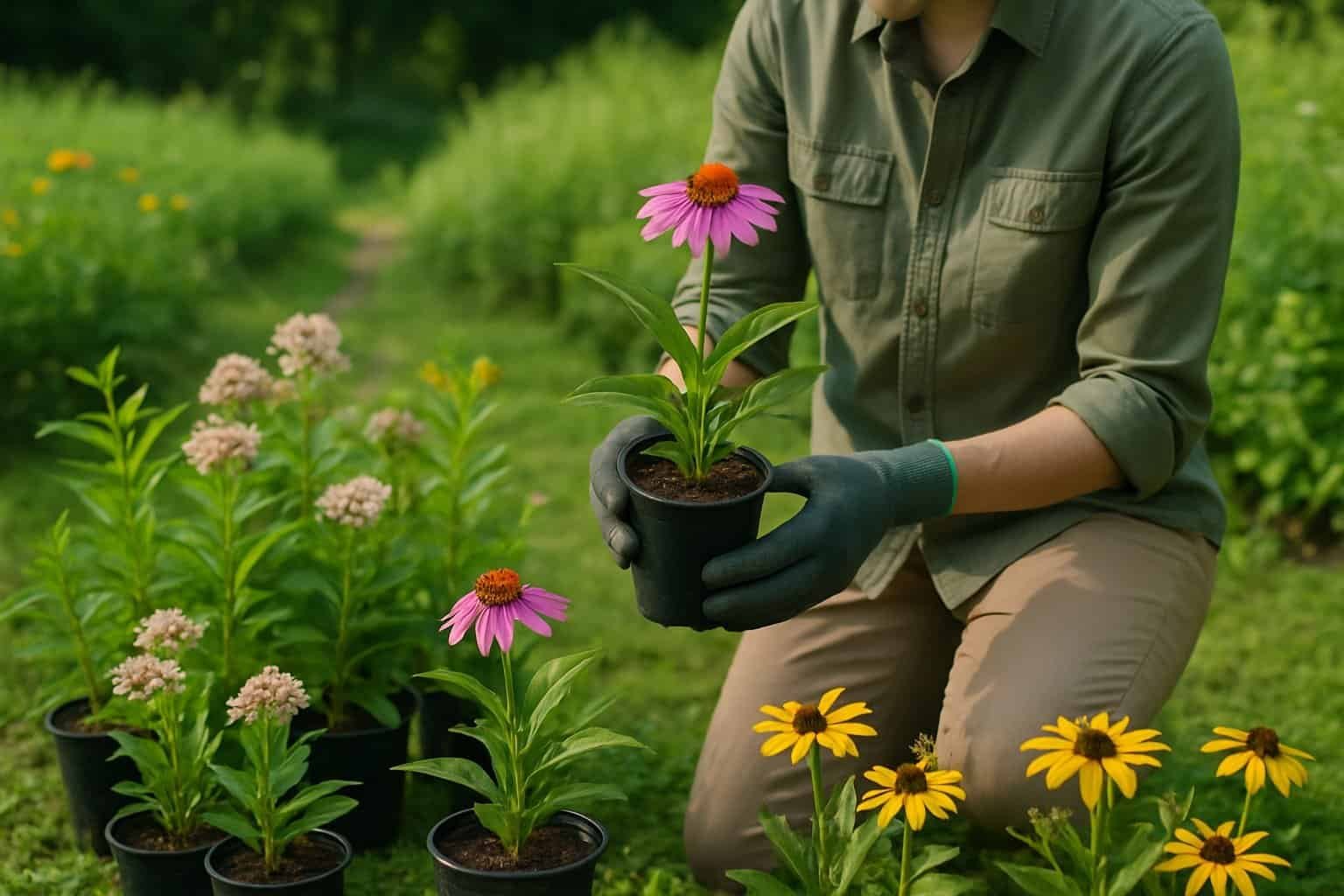
Choosing native Indiana plants for your garden requires understanding your specific growing conditions and goals. Native plants are adapted to local conditions and provide important habitat for wildlife.
Perennials, Trees, and Shrubs
Native perennials offer beauty and ecological benefits with minimal maintenance. Popular choices include Purple Coneflower, Wild Bergamot, and Black-Eyed Susan, which return year after year with vibrant blooms.
For larger spaces, native trees and shrubs create structure and habitat. Oak trees support over 500 species of caterpillars, providing essential food for birds.
Serviceberry produces early spring flowers, summer berries, and fall color. Shrubs like American Hazelnut and Spicebush work well in transitional areas.
These woody plants develop deep root systems that prevent erosion and improve soil health over time.
Pollinator-Friendly Selections
Indiana’s native pollinators depend on specific plants for survival. Monarch butterflies need milkweed varieties like Butterfly Weed and Common Milkweed for reproduction.
Other nectar plants that attract butterflies include:
- Joe-Pye Weed
- New England Aster
- Blazing Star
Bees benefit from early bloomers like Virginia Bluebells and late-season flowers such as Goldenrod. This creates a “pollinator corridor” providing food throughout the growing season.
Native plants also serve as shelter plants, offering protection for beneficial insects. Leaving stems and seed heads standing through winter provides important habitat for overwintering insects.
Soil and Sunlight Considerations
Before purchasing native plants, assess your garden’s soil type and sunlight patterns. Sandy soils support different species than clay or loam.
For wet areas, consider:
- Cardinal Flower
- Blue Flag Iris
- Swamp Milkweed
Dry, sunny locations benefit from drought-tolerant options like Little Bluestem grass and Prairie Dropseed. Woodland gardens with partial shade work well with Wild Ginger and Woodland Phlox.
Most native plant nurseries can recommend species suited to specific conditions. Soil testing helps determine pH levels and fertility, which influences plant selection and success.
Ensuring Quality and Sustainability When Purchasing
When buying Indiana native plants, quality and sustainable growing practices matter as much as the plants themselves. Choosing sellers with proper certifications and ethical growing practices helps protect Indiana’s ecosystems and ensures healthier plants for your garden.
Certified Organic and Neonic-Free Sellers
Look for nurseries with organic certification when purchasing native plants. These growers follow strict guidelines that prohibit synthetic pesticides and fertilizers.
Certified organic plants are grown without chemicals that can harm beneficial insects and soil health. Many Indiana nurseries now offer neonic-free plants.
Neonicotinoids are pesticides that can remain in plant tissues and harm pollinators like bees and butterflies. Ask sellers directly about their pesticide practices if this information isn’t clearly displayed.
Some quality nurseries may not have formal organic certification due to costs but still follow organic practices. Ask about their growing methods, including whether they use herbicides or other chemicals in their production process.
Invasive-Free Growers
Invasive-free growers take extra precautions to ensure their plants won’t spread aggressively beyond where they’re planted. These sellers carefully manage their growing areas to prevent contamination from invasive species.
Signs of an invasive-free grower:
- Clear labeling of plant origins
- Clean growing facilities
- Knowledge about invasive plant concerns
- Proper soil management practices
The best growers maintain separation between different plant species and regularly inspect their inventory. They train staff to identify potential invasive plants and remove them before they contaminate native plant stock.
Ask about how they manage their growing environment and what measures they take to prevent invasive species introduction.
Avoiding Invasive Species
Learning to identify invasive plants is crucial when shopping for natives. Some common invasive plants in Indiana include:
| Invasive Plant | Native Alternative |
|---|---|
| Purple loosestrife | Blazing star |
| Bradford pear | Serviceberry |
| Japanese barberry | Ninebark |
| Burning bush | Virginia sweetspire |
| Callery pear | Redbud |
Be wary of plants labeled as “vigorous spreaders” or “fast-growing ground covers.” These terms sometimes disguise invasive tendencies.
Research any unfamiliar plant before purchasing. Trust nurseries that specialize in native plants and can explain the ecological benefits of their selections.
Working with Experts and Community Organizations
Getting professional help and connecting with local organizations can make your native plant journey easier. These resources offer specialized knowledge, design expertise, and ongoing support for your Indiana native plant projects.
Landscape Designers and Garden Design
Professional landscape designers in Indiana can create beautiful native plant gardens that suit your specific needs. Many designers now specialize in eco-friendly approaches using local species.
When selecting a designer, look for those with native plant certification or experience with natural landscaping. These experts help with:
- Site analysis and soil testing
- Plant selection based on your location’s conditions
- Creating multi-season visual interest
- Installation planning and contractor coordination
Most designers offer tiered services from simple consultations ($75-150) to complete design packages ($500-2,500). Companies like Eco Logic, Cardno Native Plant Nursery, and Wild Birds Unlimited often provide both design and installation services throughout Indiana.
The Indiana Native Plant Society
The Indiana Native Plant Society (INPS) serves as a valuable resource for plant enthusiasts across the state. With regional chapters in Indianapolis, Bloomington, Fort Wayne, and other cities, members gain access to local expertise and plant sales.
INPS offers:
- Annual conferences with expert speakers
- Plant swaps where members exchange native species
- Field trips to natural areas with guided identification
- Quarterly newsletter with seasonal gardening tips
Membership costs $18 annually for individuals and provides discounts at participating nurseries. Their website (indiananativeplants.org) features a comprehensive database of Indiana natives with growing information and supplier listings.
Education and Stewardship
Learning proper native plant care helps your garden thrive and supports local ecosystems. Many organizations offer workshops and volunteer opportunities to build your knowledge and skills.
Key educational resources include:
- Purdue Extension offices in every county offer free gardening advice.
- The Indianapolis Museum of Art’s Virginia B. Fairbanks Art & Nature Park hosts monthly workshops.
- Local nature centers like Eagle Creek Park organize seasonal planting events.
Stewardship programs maintain public native spaces and teach practical skills. The “Grow Indiana Natives” certification program recognizes homeowners who use at least 50% native plants.
These programs create community and habitat corridors in neighborhoods.
Designing and Installing Your Native Plant Garden
Planning your Indiana native plant garden starts with thoughtful design choices. Mimic natural plant communities to support wildlife and create a beautiful, low-maintenance landscape.
Plant Layout and Placement
Consider each plant species’ needs when designing your garden. Group plants with similar water and sunlight requirements together.
Place shorter plants in front and taller ones in the back in sunny areas to ensure all receive enough light. In shadier spots, woodland natives like ferns and wild ginger thrive beneath canopy trees.
Create clusters of 3-7 of the same species for a natural look and stronger visual impact. Avoid planting single specimens.
Select plants with different bloom times to provide continuous flowering from spring through fall. Pay attention to mature plant sizes and allow enough space between plants to prevent overcrowding.
Naturalistic Planting Principles
Natural plant communities do not grow in straight lines or perfect spacing. Create irregular, flowing groupings that blend together at the edges.
Layer your garden vertically with ground covers, medium-height perennials, taller perennials and shrubs, and small trees if space allows.
Mix plants with different textures and forms. Combine grasses with broad-leaved plants and include both upright and spreading growth habits for variety.
Let some plants self-seed naturally to create a dynamic garden that evolves over time. Leave a small amount of leaf litter and plant debris to provide habitat for beneficial insects and return nutrients to the soil.
Maintaining Soil Health
Healthy soil supports a thriving native plant garden. Test your soil before planting to learn its composition and pH level.
Most Indiana natives prefer well-draining soil. If you have heavy clay, add compost to improve drainage and prevent root rot.
Work 2-3 inches of compost into the top 6 inches of soil. Avoid synthetic fertilizers, which can weaken plants.
Top-dress with a thin layer of compost each year to replenish nutrients naturally. Mulch with shredded leaves or pine needles to conserve moisture, suppress weeds, add organic matter, and protect soil from temperature extremes.
Leave fallen leaves in beds during winter. They insulate plant roots and provide habitat for beneficial insects.
Maximizing Ecological Benefits
Native plants create healthy ecosystems in your garden and the broader environment. These plants evolved with local wildlife and provide essential resources that non-native species often lack.
Supporting Pollinators and Local Wildlife
Native plants offer crucial habitat and food for Indiana’s wildlife. Bees, butterflies, and birds depend on these plants throughout their life cycles.
Key pollinator plants include:
- Purple coneflower (Echinacea purpurea)
- Wild bergamot (Monarda fistulosa)
- New England aster (Symphyotrichum novae-angliae)
Gardens with native plants support 3-5 times more bird and butterfly species than gardens with non-natives. Cardinals, chickadees, and goldfinches visit native gardens for seeds, while caterpillars feed on native leaves.
Leave seed heads intact through winter to provide food during scarce months. Dead stems offer nesting materials and overwintering sites for beneficial insects.
Creating an Ecologically Beneficial Garden
An ecologically beneficial garden works with nature. This approach reduces maintenance and supports biodiversity.
Garden design tips:
- Plant in layers—trees, shrubs, perennials, and groundcovers.
- Group plants with similar needs together.
- Include plants that bloom in different seasons.
Reduce lawn areas and replace them with diverse plantings. Even small gardens can make a difference when connected to other native plantings in a neighborhood.
Avoid pesticides that harm beneficial insects. As your garden matures, birds and predatory insects help control pests.
Environmentally Thoughtful Plant Choices
Choose native plants adapted to your specific site conditions for beauty and environmental benefits.
Consider these factors:
- Sun exposure (full sun, part shade, full shade)
- Soil moisture (dry, medium, wet)
- Soil type (clay, loam, sandy)
Native plants need less water once established, reducing the need for irrigation. They thrive in Indiana’s climate and soil conditions without extra resources.
Look for local ecotypes—plants grown from seeds collected nearby. These plants adapt best to local conditions and provide the most ecological value.
Organizations like Grow Indiana Natives can help you find suppliers of local ecotypes.
Frequently Asked Questions
Indiana native plants offer unique benefits for gardens and ecosystems across the state. These locally adapted species thrive in Indiana’s climate while supporting wildlife and reducing maintenance needs.
Which nurseries specialize in Indiana native plant species?
Several nurseries across Indiana focus on native plants. Cardno Native Plant Nursery in Walkerton offers prairie, wetland, and woodland species.
Spence Restoration Nursery in Muncie provides restoration-grade natives for gardens and large projects. Naturally Native Nursery in South Bend maintains a diverse inventory, including woodland and prairie plants.
How can I identify trustworthy online retailers for Indiana native plants?
Choose online retailers that state where their plants are grown and provide detailed information about each species’ native range.
Trustworthy retailers usually belong to organizations like the Indiana Native Plant Society or hold certifications from ecological restoration groups.
Check customer reviews and ask if plants are propagated rather than wild-collected. Propagated plants protect natural populations.
What should I look for when selecting Indiana native plants for home gardens?
Consider your growing conditions—soil type, sun exposure, and moisture levels. Native plants thrive when matched to conditions similar to their natural habitats.
Choose plants that provide food for pollinators and create seasonal interest with flowers, fall color, or seed heads.
Select a mix of grasses, flowering perennials, shrubs, and trees to create a balanced ecosystem in your garden.
When is the optimal planting season for native plants in Indiana?
Spring (April to early June) offers ideal conditions for most native species and gives plants time to establish before summer heat.
Fall (September to late October) is another good planting window. Cooler weather allows root development before winter dormancy.
Some native seeds need winter stratification and perform best when planted in late fall to experience cold conditions naturally.
How do Indiana native plants contribute to local ecosystem health?
Native plants provide essential food and habitat for local wildlife, supporting over 400 species of native bees and countless butterflies, birds, and beneficial insects.
These plants help manage stormwater by increasing soil absorption. They reduce erosion and flooding while filtering pollutants.
Deep-rooted native species improve soil structure and sequester carbon, which helps mitigate climate change impacts across Indiana landscapes.
What are the economic benefits of choosing native plants over non-native varieties?
Native plants usually need less water, fertilizer, and maintenance once they are established. This can reduce long-term landscaping costs by up to 75% compared to traditional landscapes.
Homeowners can save money on lawn care services and equipment by replacing some turf grass with native plant gardens.
Native landscaping can increase property values by 5-15%. Some municipalities also offer conservation incentives or stormwater reduction credits for properties with native plants.

